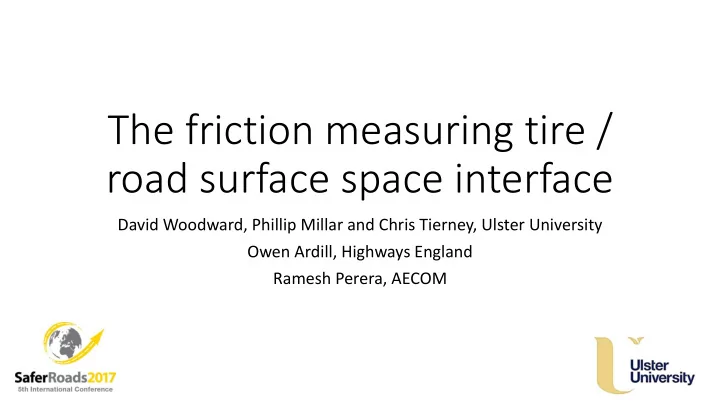

The friction measuring tire / road surface space interface David Woodward, Phillip Millar and Chris Tierney, Ulster University Owen Ardill, Highways England Ramesh Perera, AECOM
Enveloping - Hamet and Klein (2000)
Enveloping - ROSANNE project (2016)
Enveloping of the tire / asphalt interface shown by paint removal
Paint removal during Friction after Polishing (Dunford, 2013)
Paint removal during PSV (Woodward et al, 2016)
Pendulum value v. % contact area 80 Pendulum tester used for PSV 70 60 50 40 Study 1 Study 2 y = -0.1257x + 59.053 30 R² = 0.1183 Study 3 20 10 0 0 50 100 Contact area with no paint (%)
3d modelling of paint loss mm 2.0 1.5 1.0 0.50 0.0
Selected aggregates – paint loss occurs to a depth of about 0.3 to 0.4 mm 0.328 mm 0.300 mm 0.377 mm NM NM Number of islands 1 NM Number of islands 8 Threshold 0.328 mm Number of islands 4 Threshold 0.377 mm Parameters Stat. Value Unit Threshold 0.300 mm Parameters Stat. Value Unit Area Sum 33.5 mm² Parameters Stat. Value Unit Area Sum 56.3 mm² Volume Sum 4.45 mm³ Area Sum 30.6 mm² Volume Sum 7.90 mm³ Volume Sum 4.63 mm³
Important tires
Time for a rolling tire to move 10 mm
TEA MK1 and MK2
Measuring the contact patch using pressure mapping
Z-axis pressure distribution within contact patches
Tire deforming into the space
Gap width – HRA and 10mm SMA
TEA MK1 - nearly new tire, 20 psi, 233.4 N load, measured in central position, straight edge profile
TEA MK2 - comparison of tires for gap spacings up to 60 mm at similar vertical loads
Conclusions • The TEA MK1 and MK2 test apparatus offer a simple means of investigating the principle of enveloping. • The laboratory investigations considered factors that can be controlled and thought to influence the envelope space. • Under static conditions and for all of the test conditions investigated, the main factor relating to tire embedment is gap width. • Amount of tire embedment decreases until a critical gap space is reached and then remains fairly constant as gap space is further decreased. • Data can be used to supplement other studies into the tire / surface interface relating to skid resistance, noise and rolling resistance.
Recommend
More recommend